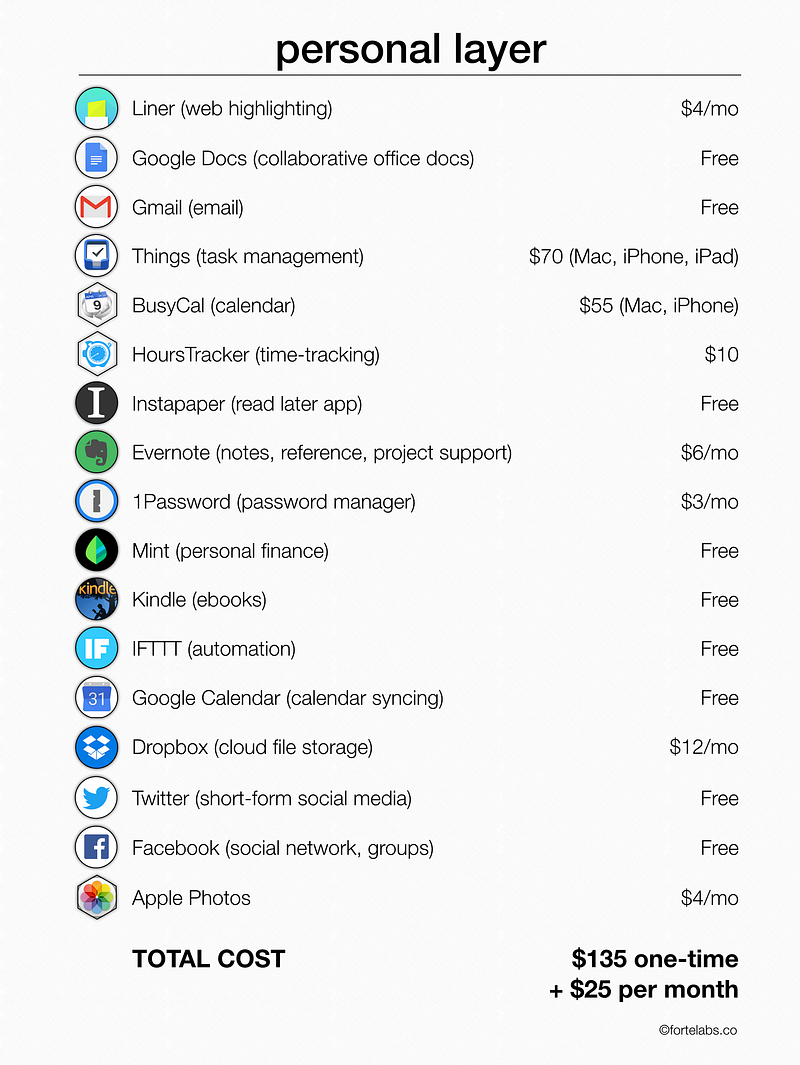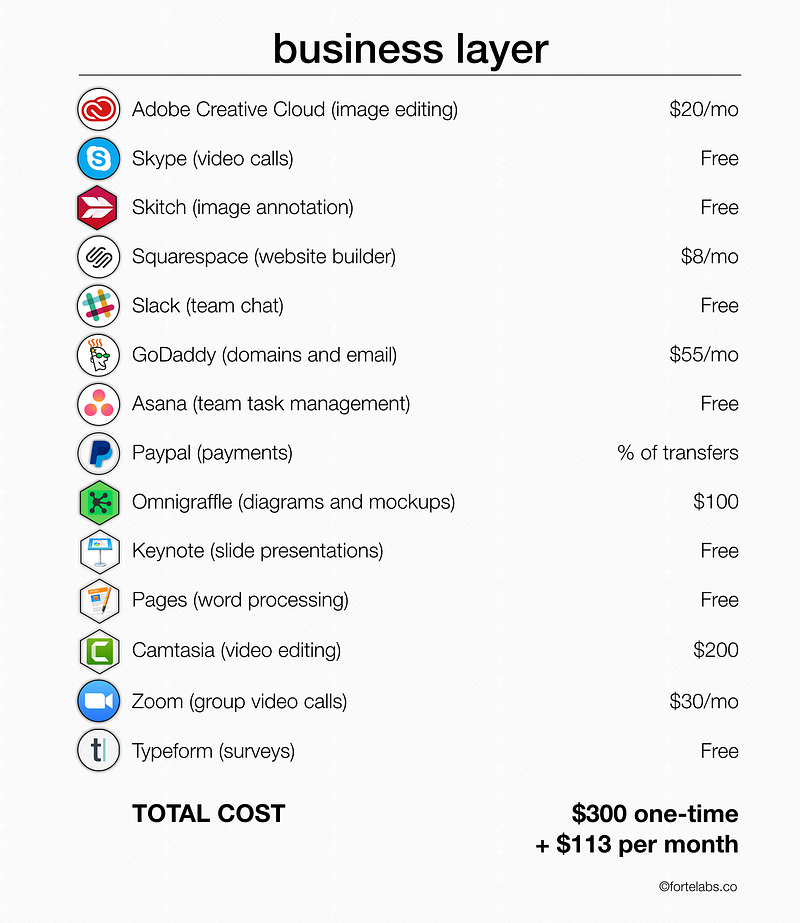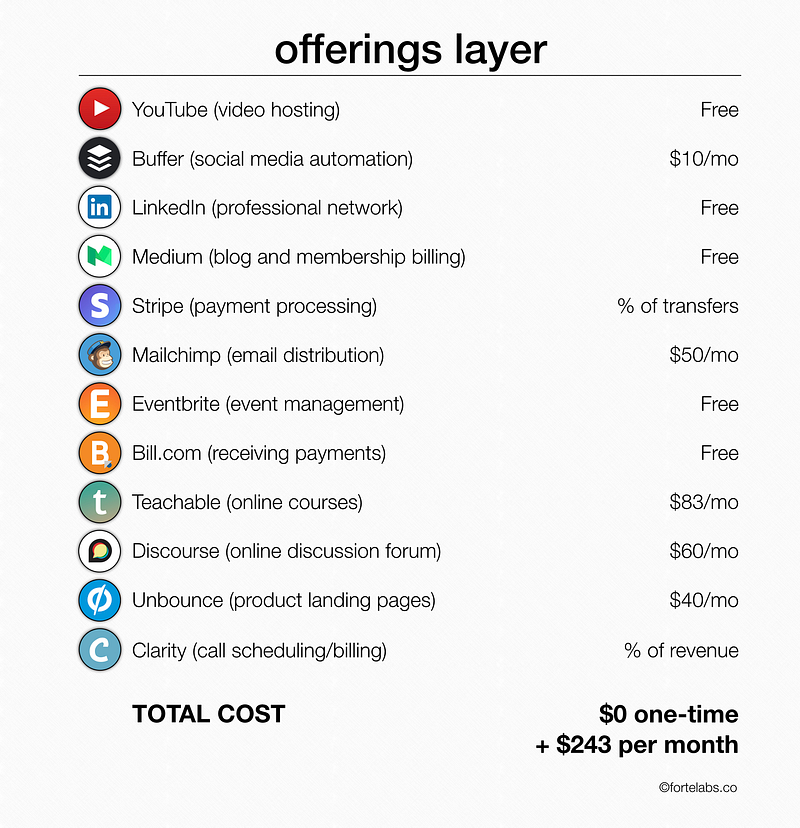In Part I, I described a new kind of worker called the Full-Stack Freelancer.
I argued that more affordable and user-friendly software-as-a-service (SaaS), among other things, has enabled individuals to manage portfolios of complementary income streams, instead of focusing on only one specialized skill.
But you may have noticed something missing: what is in the stack?
Here’s mine:

This includes all the primary apps and services I use to manage my life, my business, and the individual products and services I offer. The total cost is:
- Personal layer: $135 one-time + $25 per month
- Business layer: $300 one-time + $113 per month
- Offerings layer: $243 per month
- GRAND TOTAL: $435 one-time + $381 per month
This article will zoom in to detail how I use each of the 44 tools above, and how much they cost. In followup articles, I’ll dive into how I chose them, how I use them together, and other implications of the full-stack life.
Personal layer
The personal layer contains tools I would use extensively even if I didn’t have a business or a job. They form a foundational layer of productivity and communication on which everything else is built.

Liner (web highlighting)
This is a browser plugin that allows me to “highlight” text on websites, and then save those passages with one click to Evernote. They have a good free version, but I like it so much I’m happy to pay.
Google Docs (collaborative office docs)
I use Google Docs for text documents and spreadsheets when I need others to view, comment on, or edit them. If I don’t need collaboration features, I default instead to Evernote.
Gmail (email)
Gmail is the world’s most popular email service, and pretty much a no-brainer for sending and receiving emails.
Things (task management)
Things is my task manager, which I use for capturing open loops, turning them into tasks, managing projects, and tracking my progress. It is a separate one-time purchase for each device, and offers a syncing service between devices.
BusyCal (calendar)
BusyCal is a calendar app for Mac and iOS. It is straightforward and reliable, which is all I require of a calendar app. It syncs with Google Calendar and other common services.
HoursTracker (time-tracking)
I use HoursTracker for tracking my time. It allows me to set up projects that I can clock into and out of on my smartphone. Clean interface, well-supported, and easy export to spreadsheet format for analysis.
Instapaper (read later app)
Instapaper is a “read later” app, allowing me to read articles and view videos saved from other locations, like social media or email. I have it set up so any passages I highlight in the app automatically get sent to Evernote.
Evernote (notes, reference material, project support)
As my “second brain,” Evernote is the default place where I keep notes, research, reference material, and project support material. It syncs all “notes” to the cloud and to my mobile devices.
1Password (password manager)
This app and browser plugin gives me a secure place to save passwords, and to fill in logins on the web without me having to remember them.
Mint (personal finance)
This is where I track my personal spending, budgets, and transactions from all my bank accounts, credit cards, and other accounts.
Kindle (ebooks)
The Kindle app (which is tied to the Amazon ebook store) is where I do my ebook reading. I extract any passages I’ve highlighted into Evernote using Bookcision.
IFTTT (automation)
This service allows me to “link together” apps and online services that don’t normally work together. I use it to automatically send highlighted passages from Instapaper to Evernote.
Google Calendar (calendar syncing)
Google Calendar allows me to sync my calendars between devices, and to send and receive “invites” for appointment times with people I’m calling or meeting with.
Dropbox (cloud file storage)
Dropbox is my cloud storage service, syncing my files between devices and allowing me to send large files to others with a single link.
Twitter (short-form social media)
Twitter is a social media network that allows me to publish short snippets of text and images, which I use to think out loud, get feedback on blog posts or ideas, and connect with interesting people.
Facebook (social network, groups)
Facebook is the world’s largest social network, and allows me to keep in touch with family and friends. I also belong to a few groups and publish blog posts and announcements there.
Business layer
The business layer contains tools I use to manage the business overall, or that are used in multiple offerings. I think of them as the “background infrastructure” I need to keep the wheels turning.

Adobe Creative Cloud (image editing)
I use Adobe Illustrator to edit and export images and graphics. I have only the most basic skills, and don’t use the program very often, but I like having its full power available to me in case I need to quickly learn a new feature.
Skype (video calls)
I prefer Zoom for group video calls, but Skype has been around for so long that most people I want to talk to already have an account.
Skitch (image annotation)
Perfect for adding quick-and-dirty arrows, underlines, and callouts to screenshots and webpages, which I can then save to Evernote or send to others.
Squarespace (website builder)
I first created a free Squarespace site when I was looking for a job in 2012. Over time, it’s evolved to include my resume, my portfolio, my products and services, and my clients. There are some drawbacks to using a drag-and-drop website builder (like a lack of control and flexibility), but I love that I can make frequent, small changes completely frictionlessly.
Slack (team chat)
I use Slack to communicate in real-time with the various collaborators and teams I work with.
GoDaddy (domains and email)
GoDaddy is my registrar, where I register domain names (for current use or speculatively), and purchase email accounts to go with those domains.
Asana (team task management)
We use Asana to coordinate who’s working on what, to track progress, and to make project plans that others can view, update, and comment on.
Paypal (payments)
I use Paypal to send and receive payments from customers and friends alike. Widely supported and easy to use.
Omnigraffle (diagrams and mockups)
Omnigraffle is a full-featured but user-friendly program for drawing diagrams, workflows, mindmaps, and mockups. It is like a digital artist’s canvas with lots of templates and shapes ready to drag and drop.
Keynote (slide presentations)
One of my most used apps, I use Keynote to design and deliver slide presentations for live talks, courses, and workshops. I also often re-use those slides in websites, blog posts, and other projects, like the graphics in this post.
Pages (word processing)
A substitute for Microsoft Word, I use Pages anytime I need to produce a nice-looking text document for sending to someone or printing. Since it’s also made by Apple, I can also easily move visual assets between Pages and Keynote.
Camtasia (video editing)
I use this program to record screen captures and other videos for my online courses. It has strong editing capabilities, lots of bells and whistles, and most importantly, is very stable and reliable (unlike iMovie).
Zoom (group video calls)
Zoom has exploded on the scene these last couple years. It’s my preference for group video calls, since it offers breakout rooms, polls, easy recording, and is well-supported on multiple platforms.
Typeform (surveys)
I use the free version of Typeform to collect information from groups of people. For example, for the onboarding surveys to my online courses. It is a lot better-looking than other survey services, offers lots of customization options, and exports results to spreadsheet format.
Offerings layer
The offerings layer contains tools needed to deliver a particular kind of product or service. I may use them in other areas as well, but for the most part I wouldn’t pay for them unless I had that offering in my portfolio.

YouTube (video hosting)
YouTube is the world’s most popular video hosting and watching service. I don’t upload videos with any regular frequency, but gradually over time have built up a nice little collection of recordings of talks and presentations.
Buffer (social media automation)
Buffer allows you to write social media posts in advance, and then “set and forget” them. They are posted at a time of your choosing, or according to when your audience is most likely to engage. I only use it in run-ups to course launches, when timing matters.
LinkedIn (professional network)
LinkedIn is useful as a storefront, as many people will start there when they want to check your credibility, what you offer, or your background. I don’t pay for the premium service.
Medium (blog and membership billing)
Medium is a blog writing and hosting website. There are limitations on what I can control, but I like that I don’t have to spend any time or money on maintenance, the interface is beautiful, and the network brings in a good number of readers. They also allow me to have a paywall for access to certain articles.
Stripe (payment processing)
Stripe works pretty much in the background for me, but allows me to do things like get instant payouts on Teachable, accept credit cards, and receive international payments. I really like that I only pay when I get paid.
Mailchimp (email distribution)
Mailchimp allows me to keep multiple email lists for distributing emails to different audiences. It has many features, including email signup forms, automation, segmentation and groups, and analytics.
Eventbrite (event management)
I use Eventbrite to manage the registration and ticketing for the occasional events I hold. Usually there is a venue managing the event, and I log in as a guest to edit the event description or check sales.
Bill.com (receiving payments)
This service is an alternative to Stripe, that some of my recurring clients use to pay me.
Teachable (online courses)
Teachable is my “school,” where my 3 online courses are hosted. It includes landing pages for each of the courses, a checkout process, and student management and communication.
Discourse (online discussion forum)
Discourse is an open-source discussion forum, used by many online communities for education, questions and answers, sharing resources, and completing exercises. I pay only $10 per month for the hosting itself, and $50 per month for an IT admin to perform updates and help us out with technical support issues.
Unbounce (product landing pages)
Unbounce is a website builder specifically geared toward landing pages for products. It allows you to create multiple parallel versions of a site for A/B testing. I’m pretty unhappy with Unbounce as it’s way too expensive for the single page I use it for, but it will have to do until I can afford to move it elsewhere.
Clarity (call scheduling/billing)
Clarity is a service that takes a lot of the friction out of one-off, on demand coaching calls. You set your rate by the minute, and anyone can schedule a call with you if they’re willing to pay it. Lacks a lot of features like minimum call times and the option to sell blocks of hours at a discount, but it’s good as a basic filtering system for cold inquiries.
Questions
In later articles I will dive into some of the counter-intuitive or surprising aspects of leveraging the stack for creative work.
For now:
- What else would you like to know about my stack?
- Do you see anything missing, or potential improvements?
- Do you know of any other open-sourced stacks, your own or others?
Follow us for the latest updates and insights around productivity and Building a Second Brain on X, Facebook, Instagram, LinkedIn, and YouTube. And if you're ready to start building your Second Brain, get the book and learn the proven method to organize your digital life and unlock your creative potential.
The Rise of the Full-Stack Freelancer Series
The Rise of the Full-Stack Freelancer The Free Agent Ecosystem- Posted in Entrepreneurship, How-To Guides, Productivity, Technology
- On
- BY Tiago Forte
